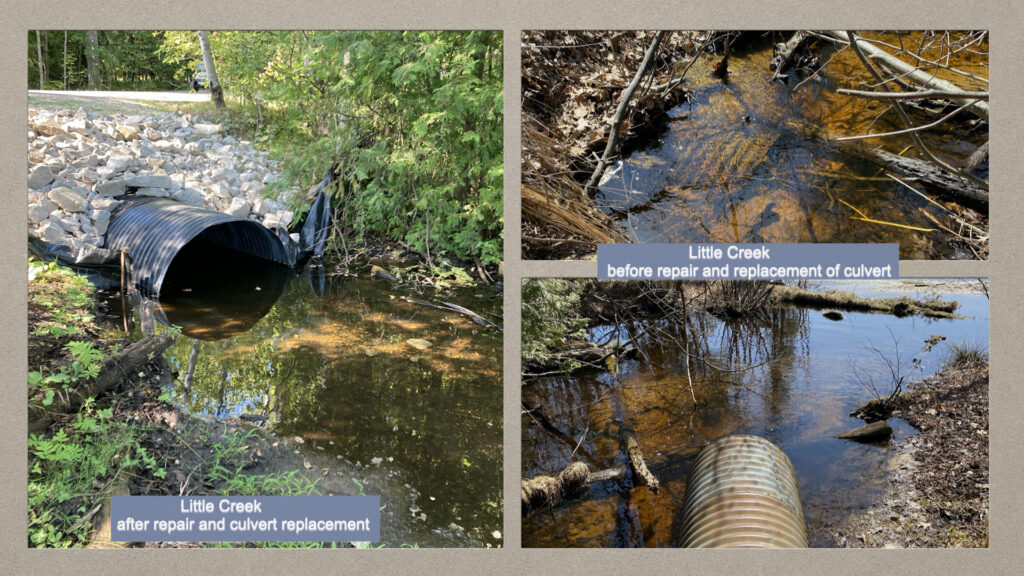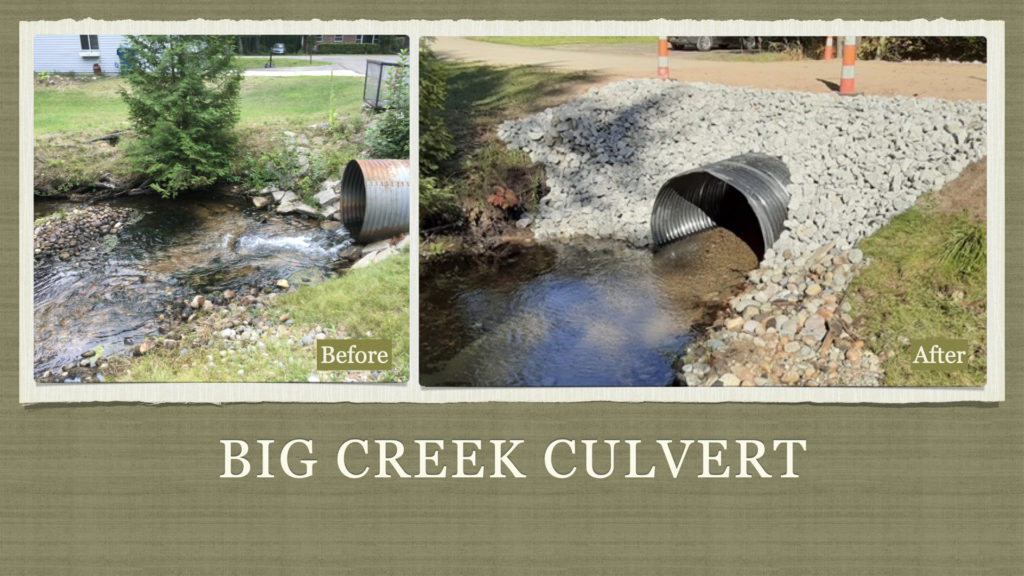
January 2021

Little Creek Culvert Repaired and Replaced 2022
Grassroots efforts restore another tributary of Higgins Lake. Little Creek culvert at Albermarle Boulevard in Lyon Township is repaired and replaced.
Huron Pines Press Release November 1, 2022: Little Creek Restoration
Habitat Improvement for Brook Trout in Big Creek 2022-2027
The replacement of the perched culvert on Dewey Road with a new culvert allowing the free passage of spawning fish upstream into the State Forest has been completed. The members of the Big Creek Lane Association working with the Higgins Lake Property Owners Association decided to improve the habitat for brook trout in Big Creek. The recommendations offered by Mark Tonello of the Michigan DNR fisheries division in this regard are quoted below:
“Recommendations: Big Creek hosts a robust, self-sustaining population of Brook Trout. However, habitat for larger trout was very limited. Much of the stream was overly wide and shallow, with very little depth (which is necessary to hold larger trout). The in stream habitat in Big Creek could be improved with a minimum of effort, using hand-placed wood to narrow and deepen the stream channel, as well as, providing overhead cover, which is also preferred by larger trout.” Mark Tonello, 2019
Working with Erin Emington of EGLE, a design for in stream habitat improvement was developed and a permit was issued for that work.
Groups of volunteers from Big Creek Lane Association, HLPOA, and interested people from around the lake have proceeded to construct and place these types of structures in Big Creek between the Dewey Road Culvert and the Treasure Boulevard Bridge. Pictures and discussions of results will follow as the work progresses.

Brook trout in Big Creek! November 10, 2021
Video clip taken by Anneke Swinehart November 10, 2021. Eight to nine inch Brook trout heading upstream from the new culvert across Dewey Road. “Wait for it, you will see the fins!”
Huron Pines Review of Dewey Road Culvert Project
April 29. 2022. Big Creek at Dewey Avenue was inventoried by Huron Pines. Check link below for the “River Restoration Fact Sheet April 29, 2022”. This culvert was replaced in 2021. Brook trout and suckers were observed upstream of culvert at the time of this survey report.
Water Quality Analyses at Big Creek
The program of sampling and analyzing the contaminants being carried into Higgins Lake via Big Creek will be continued in 2021. The effort is focused on establishing year-around base line data to compare against future improvements expected through various remediation efforts. It appears that most of the flow in Big Creek comes from ground water sources between the county road and the creek’s entry into the lake, and the impact of residential and commercial activities in the creek’s watershed will be examined as the program continues.
Big Creek Water Quality 2021 – 2022
DNR Report on Big Creek Fishery – 2019:
Attached, below, is the Final DNR Fisheries report of the scientific study of the fish population and stream morphology of Big Creek in 2019. The fish data were taken between the Dewey Road perched culvert and the mouth of the creek. It is an important environmental work with clear recommendations on how to restore and remediate this cold water fish nursery and fishery resource for Higgins Lake.
The study was done in the summer, and the stability of the stream’s temperature in a good range for trout and similar cold water species is very significant. It is important to note that several species of small trout were found, including brook trout which are not planted by the DNR and some rainbow trout smaller than the ones planted in the lake by the DNR. This indicates that both brook trout and rainbow trout spawn successfully in Big Creek. They presumably migrate back into the lake when they grow too large to remain comfortably in the creek itself. Many anecdotal tales of large brook trout caught off the mouth of Big Creek in past years tend to support this likely behavior.
The report states that a key to improving the productivity of this creek as a cold water fish spawning habitat is replacing the perched (i.e.: raised) culvert on Dewey road with a full stream width crossing allowing unhindered fish passage. This would substantially increase the amount of stream habitat available for spawning fish coming upstream from the lake. We are pursuing this project with Lyon Township, the Roscommon County Road Commission and several outside funding agencies. We will report progress in future discussions.
Also noted was the fact that every small depression and protected area in the stream held trout. This suggests that some small projects by well led volunteers could greatly improve the trout habitat. For example, several in-stream current deflectors, several over-stream shade structures, and perhaps some small stream bank stabilization projects would make a big difference in ambient fish populations.
The study also mentions the problems caused by the upstream beaver population. Their culvert blocking constructions and the removal of such material by the Road Commission has been the cause of much debris flow into the lake and is a problem for riparian owners in the vicinity. Working out a good environmentally acceptable solution to this problem is a future project for our Environmental Committee.
Maintaining the High Water Quality of Higgins Lake – Bosserman 1969
This very interesting historical document from 1969 was authored by William T. Bosserman, the County Extension Director for Roscommon and Crawford Counties at the
Request of the HLPOA and other interested parties around the lake. It was discovered by HLPOA member Melanie Brown in the collected papers of her father-in-law J.D.Brown, who was an active member of the HLPOA during those years. The focus of Bosserman’s effort was to identify potential sources of pollution entering the lake through man made and natural creeks and drains around the shoreline.
To accomplish this survey, “the author walked the entire distance around Higgins Lake in April 1969 taking note of man made and natural drains into the lake and other possible sources of pollutants caused by present land use.”
Thus we have a very complete and accurate inventory of the location of creeks and drains upon which to base our future studies to determine and moderate the negative impact these potential pollution sources may present.
In any case it makes most interesting reading!
Maintaining the High Water Quality of Higgins Lake 1969 Report


